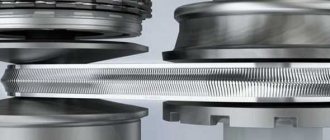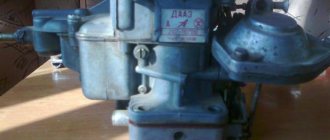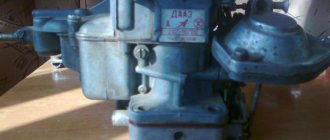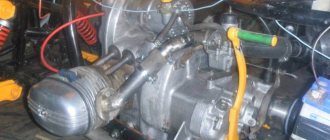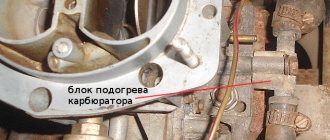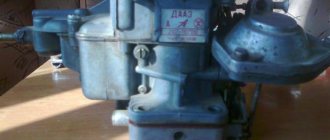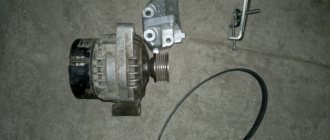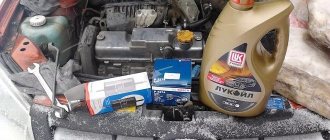Standard "glushak" - what's bad?
Actually, we’re starting to get to the most interesting part, what’s wrong with the standard system? Why does it urgently need to be replaced (I think all tuners do this)?
To begin with, what is formula 4-1 - these are four pipes (from each cylinder) that are connected at one point (pipe) and then the whole thing goes into the main path through the catalyst, resonators, etc.
NOW WHY IS SHE NOT DEVELOPED? As a rule, to please engineers, environmentalists and others, the manufacturer makes short pipes from the engine cylinders, which are immediately connected into one. Why is this bad? YES because the distance to neighboring pipes is very short. During exhaust, a certain wave is formed, which should remove gases into the main exhaust - BUT this wave also enters adjacent pipes and cylinders, thereby inhibiting the removal of gases. The situation is aggravated by the presence of a catalyst (because it is a filter and creates additional resistance), the presence of advanced resonators (sound is damped well, but gas removal is worse) and the diameter of the pipe (often made thin, within reason of course).
To put it in simple words, the engine seems to be strangling itself, that is, this is the UNDEVELOPMENT of the gas exhaust system. The engine must “breathe” (discharge waste freely), thereby increasing the power.
Causes of failure and replacement of the Priora catalyst 16 valves
Experts identify several main factors that can lead to catalyst failure:
- Impact - yes, the most common impact with the bottom on a stone or curb. It will most likely lead to the appearance of microcracks, which will only increase as the vehicle continues to be used;
- Filling a car with low-quality fuel, as well as using various types of additives (for most types of catalysts, fuel additives are strictly contraindicated).
- Improper care of the catalytic converter, as well as reluctance to carry out routine diagnostics of the element.
Spider Efficiency
There are a lot of companies on the Internet that say almost the same thing, put a spider on your VAZ and the power will immediately increase by 10% - WOW! That is, it was 100 hp. and then it’s 110 right away, and I’ll tell you this is noticeable!
BUT IS THIS REALLY SO? Let's understand it logically:
- Installation requires removal of the catalyst. And it has already been proven that removing this filter adds 4 to 5% power
- You need to flash it for EURO 2 - 3. Otherwise, there is no filter element! But with firmware you can catch up your car to 7 - 10% power
- Other resonators are installed. Sports as they are called! They have less resistance by another + 2-3%
- Sometimes this entire system is made from a larger pipe with a diameter of 51 mm.
SO what does the spider itself do and is it really +10%? Most likely no! YES, it gives a small increase, about 2-3% on its own (but you won’t be able to feel them, because this is at the error level). YES, and this performance OFTEN happens only in a limited range of work, for example 5000 - 6000 rpm (not always, but OFTEN). YOU need to understand that if you are planning to install it, then you need to do it in conjunction with other operations, otherwise the effect will be almost undetectable.
Now we are watching the video version.
323,78
Source
What is the problem with release anyway?
There are only two problems:
- It's noise. That's why the exhaust system is often called a muffler to dampen loud sounds.
- This is ecology. Not all gases burn in the combustion chamber, and to put it in “simple language” they need to be “burned or decomposed” into more or less safe components, this is done by the catalyst.
If there were no muffler, the engine power would be approximately 10% more by default (depending on the valve and camshaft settings). BUT it would be impossible to drive such a car, firstly, you yourself would become deaf from the crackling sound that escapes from the engine (and you would be fined for disturbing the peace of citizens, this is now punishable by law), and secondly, the environmental component would be worse zero, because there is no catalyst (and we already have a polluted world that requires global cleaning) - it is not possible to pass MOT with such an indicator, and even now traffic police officers can easily check the exhaust.
In general, the gas muffling system CANNOT be removed, but it can be improved, which is exactly what tuners do.
Signs of a bad catalytic converter
The declared service life of the VAZ-2170 catalyst is 140 thousand kilometers. However, this does not mean that after this mileage the device needs to be changed. It can last much longer, or it can fail even after traveling 10 thousand km. It all depends on how you use the car.
How do you know when it's time to change the catalyst? "Priora", being a car stuffed with various sensors, will first of all let you know about this with a burning CHECK light on the dashboard (when reading the code, error 0420). Failure of the catalytic converter is also accompanied by:
- difficult (long) process of starting the engine;
- reduction in power characteristics;
- increased fuel consumption;
- floating speed at idle;
- uncharacteristic sounds of a running engine;
- pungent (acrid) smell of exhaust gases.
Spider 4-2-1 and 4-1. Like tuning the exhaust system. What is it and why is it needed at all?
"Spider" - replacing the exhaust manifold
Most of the exhaust losses occur in the exhaust manifold. In tuning, it is replaced with the so-called “spider” - it differs in the shape and order of connection of the exhaust pipes with the exhaust windows. “Spiders” are “short” and “long” (two U). If we take a 4-cylinder engine, then the “long” pipe diagram is built according to the formula 4-2-1, and the “short” one is 4-1. The “long” spider has a 2->1 coupling, while the “short” one has a more complex geometry.
The 4-1 spider installation provides additional power in a narrow speed range, beyond 6000 rpm, and is used for highly boosted engines with wide-phase camshafts, i.e. on sports cars. Spider 4-2-1 is suitable for amateur tuning, because... provide an increase in power and torque over a wide speed range. Adding power - 5-7%.
When tuning, intermediate straight pipes of increased diameter and resonators of reduced resistance are used. Instead of rigid connections, “corrugations” (bellows) or ball joints are installed. The latter do not create parasitic resonance frequencies, but are short-lived. But the “corrugations” soften shocks during startup and a sharp increase in power.
Experiments with exhaust pipes have proven that the length of the pipe does not affect the efficiency of cleaning the cylinder, but as it increases, the vacuum increases. Therefore, each engine operating mode corresponds to the optimal length of the exhaust pipe - the shorter and larger the diameter of the pipe, the lower its flow resistance.
Replacement with a sports “can”
Most tuning mufflers are universal, they can be adjusted to any car. For amateur tuning, it is recommended to buy only the end part, the so-called “can”
When choosing it, pay attention to the material from which it is made and the design: one or two outlets, straight pipes, pipes curved up or down. And, of course, to the sound
Please note: after the muffler runs in, the timbre and tonality change.
This is done to improve the sound of the car.
What is a spider on a car for? What is a spider on a car, what is it for and how does it work.
Uh.. this is overall more….. Sorcerer? And there’s certainly a lot to think about...
REAL DISADVANTAGES OF REMOVAL OF THE LADA VESTA CATALYST OF THE YEAR Well said above, support... The Lord is with you!
Fuel consumption 14.2 is amazing
Yes, the damage to the environment is fucked up. Gazprom plants and, in fact, everything else, this is directly worse than EVERYTHING. Think for yourself.
Damn, so smart sho. Why aren't you still working as an engineer? Laughed heartily at all this nonsense. Before my wife, I had two Lanos, so the cat was located there after the corrugation and why didn’t it burn out? In the film, I put the cat there just to add, there was zero difference in dynamics, I took copies and put a stronger and also didn’t see the difference. What the hell difference do you want to see after removing the kata and firmware? You have to dig deeper into the intake, exhaust, shafts and change the firmware, but in the coupe it’s minimal, you’ll see a noticeable difference. You are ananism. I upgraded to Euro2 to somehow improve the sensitivity of the gas pedal and remove the hesitation of the engine. Before the firmware update, the exhaust smoked and there was soot after the chip, the soot went away. This is the maximum that the firmware will solve. You can see the three-layer corrugation burned out.
What is a “spider” for Priora and what is it for?
Tuning the exhaust system of the Lada Priora includes replacing the exhaust manifold with a similar sports version, which is called the “spider”. The main difference between the original manifold and the spider is that the latter has a larger diameter and the same length of outlet pipes, which facilitates the rapid release of exhaust gases from the cylinders to the exhaust pipe.
This spider design prevents exhaust gases from flowing back into the combustion chamber, which increases engine power and performance. In addition, the manifold performs the function of purging the combustion chamber and filling it with a combustible mixture due to the pressure that is created when exhaust gases are released.
Stinger exhaust kit
To tune the Priora exhaust system, a ready-made kit for installing a direct-flow Stinger exhaust with additional components that are perfectly attached to each other is often used. As a rule, the tuning kit includes the following parts:
- new muffler with nozzle;
- spider;
- resonator Stinger Sport with a pipe diameter of 51mm.
The need to install a “spider” on Priora arises when:
- long vehicle acceleration time;
- low engine power;
- failure of the old exhaust system, where installing a spider on a Priora is considered as an alternative to the old one.
On the tuning parts market there are many modifications of “spiders” made by different manufacturers. Some models are produced without oxygen sensors, which requires reflashing the electronic engine control unit.
There are spiders with long and short pipes, which are indicated by the corresponding numbers 4-2-1 and 4-1. These designations reflect the shape of the spider pipes, that is, 4 pipes merge into 2, and then into 1, in the second option, respectively, 4 pipes are immediately combined into one, which significantly reduces the length.
The most popular among car enthusiasts has become the long spider 4-2-1, which, unlike the short one, shows good results in a wide speed range. A short spider 4-1 is better suited for forced engines operating at 6-10 thousand rpm.
STAGED CAR TUNING. No. 7 – EXHAUST MANIFOLD – “SPIDER 4-2-1”.
Friends, I welcome you!
So, We got to the exhaust manifold, which also has popular names “spider, pants”, etc. Let's start, as usual, with the fact that this manifold has an increased cross-section, starting from the flange attached to the cylinder head to the flange connecting to the resonator. However, there are two more very important details.
First. This spider, along its entire length, conically increases the diameter of the pipes, which is fully consistent with the theory of internal combustion engines - the channels should be thicker the farther away.
Second. It’s not for nothing that the shape of this spider is called 4-2-1, but the fact is that cylinders 1 and 4 are connected into one pipe, and similarly cylinders 2 and 3, and only then these pipes converge into the final one. The differences from the standard one are significant. Plus, a nice thing is that this manifold already has a nut for a lambda probe (or SDK sensor) for online calibration of the motor, but in a standard one you will have to weld such a nut.
There are also collectors in the 4-1 form, when a pipe comes from each cylinder and they all converge into one final one at the end. Which one should you take and which one is better?
The fact is that the 4-2-1 spider works more efficiently in the operating speed range up to 8,000.00, but the 4-1 spider works after that. I won’t describe in detail the physics of these processes with formulas and calculations, because this will already become complete physics. I’ll just say that such a phenomenon takes place and it is connected with the same acoustic wave (this phenomenon is written about in article No. 6).
I found a lot of complaints and complaints on the Internet about the poor quality of these sports spiders, some had a completely wrong bend and it simply did not fit into place, some had through holes in the cylinder head flange and much more. I was lucky, the collector turned out to be of high quality and immediately installed as expected.
Let's look at the effect. Once again we see a change in the exhaust sound, now it is even quieter and more thoroughbred. The increase in power is a little more significant; when replacing the manifold, the effect is greater than when replacing a muffler or resonator, we estimate it at approximately 3%. In total, we get around 87.5 l/s from our engine.
What if we estimate all the already installed upgrades on the Priora? After all, power is added as a percentage, and the initial indicator of the Priora engine is 108 forces? And in the end we get the following: an increase of 11.5% in horses is 13.4 l/s, and engine power increases to 121.4 l/s, I note that this is almost the figure for the grants-sport 125 forces.
The cost of the collector is the least expensive of this entire group - I bought it for RUB 1,000.00.
Source
I installed the spider, do I need firmware?
Currently, there are a large number of manufacturers of sports spiders. They all claim that by installing a 4-1 spider or 4-2-1, the power of your four-cylinder engine will increase by up to 10%. This is confirmed by video clips and measurements on a dyno, but is it really so? Manufacturers don’t tell us a little, since replacing the standard manifold with a spider will disrupt the correct operation of the engine.
When a new car is produced, a standard program is installed in the engine control unit, which monitors exhaust gases and is set to a certain pressure in the exhaust manifold. When installing the spider, the pressure in the exhaust system changes and an engine error light appears on the dashboard. At the same time, the car begins to consume more gasoline and its power drops significantly. In order to avoid this, it is necessary to change the factory engine settings to the so-called euro two firmware, or even zero euro. Such firmware is more universal and can be easily installed at service stations where they do chip tuning. But absolutely identical motors simply do not exist, and in order to achieve maximum performance when installing a spider, you need to individually calibrate your engine.
Source
Advantages and disadvantages of installing a spider on a VAZ 2170
After installing the “spider” on the VAZ 2170, Priora owners note the following positive changes in its operation:
- the car accelerates faster;
- the maneuverability of the car on the road improves;
- the engine sound is reminiscent of a sports car engine;
- the engine becomes more powerful up to 10 hp;
However, often a change in the design of the exhaust system associated with the installation of a spider can also have negative consequences:
- engine noise often becomes higher and is transmitted into the car interior;
- there is a need to reflash the electronic engine control unit after installing the spider.
Spider Efficiency
There are a lot of companies on the Internet that say almost the same thing, put a spider on your VAZ and the power will immediately increase by 10% - WOW! That is, it was 100 hp. and then it’s 110 right away, and I’ll tell you this is noticeable!
BUT IS THIS REALLY SO? Let's understand it logically:
- Installation requires removal of the catalyst. And it has already been proven that removing this filter adds 4 to 5% power
- You need to flash it for EURO 2 - 3. Otherwise, there is no filter element! But with firmware you can catch up your car to 7 - 10% power
- Other resonators are installed. Sports as they are called! They have less resistance by another + 2-3%
- Sometimes this entire system is made from a larger pipe with a diameter of 51 mm.
SO what does the spider itself do and is it really +10%? Most likely no! YES, it gives a small increase, about 2-3% on its own (but you won’t be able to feel them, because this is at the error level). YES, and this performance OFTEN happens only in a limited range of work, for example 5000 - 6000 rpm (not always, but OFTEN). YOU need to understand that if you are planning to install it, then you need to do it in conjunction with other operations, otherwise the effect will be almost undetectable.
Now we are watching the video version.
Similar news
- Removing the catalyst. Pros and cons, consumption, firmware - revealed...
- Water in the muffler. Reasons, how to get rid of it and whether it can be drilled
- Catalyst service life. When should it be changed?
What is the problem with release anyway?
There are only two problems:
- It's noise. That's why the exhaust system is often called a muffler to dampen loud sounds.
- This is ecology. Not all gases burn in the combustion chamber, and to put it in “simple language” they need to be “burned or decomposed” into more or less safe components, this is done by the catalyst.
If there were no muffler, the engine power would be approximately 10% more by default (depending on the valve and camshaft settings). BUT it would be impossible to drive such a car, firstly, you yourself would become deaf from the crackling sound that escapes from the engine (and you would be fined for disturbing the peace of citizens, this is now punishable by law), and secondly, the environmental component would be worse zero, because there is no catalyst (and we already have a polluted world that requires global cleaning) - it is not possible to pass MOT with such an indicator, and even now traffic police officers can easily check the exhaust.
In general, the gas muffling system CANNOT be removed, but it can be improved, which is exactly what tuners do.
Is there an alternative
Will Priora work without a catalyst? Of course it will be! The absence of a catalytic converter will not affect its performance in any way, as some “experienced” craftsmen claim. Yes, the car will no longer meet established environmental standards, but it will not work any worse.
If you don’t want to spend money on a standard catalyst, you can always buy a universal device, which will cost you half the price, taking into account installation. Essentially, it is the same catalytic converter with the same functions and similar design. And they are produced mainly in the same factories as the original ones, and their price is lower due to the absence of various trade markups.
Well, if you want to easily tune your Priora, buy a good flame arrester for it. It is installed instead of a catalyst. With it, the engine power will increase due to improved exhaust gas flow, and the sound of the power unit will acquire sporty notes.
A few myths
Installing spacers harms the car and the environment
Some people specifically remove the catalyst, while others do not pay any attention to the faulty unit. As a result, several myths about this device appeared among the people:
- The first misconception is that after getting rid of this unit, the car noticeably increases its power. For what reasons it arose is unknown.
- Secondly, the power unit with the catalyst “suffocates”. Totally absurd. If the catalyst is working properly, the engine functions normally.
- Where the myth came from that a clogged catalyst makes the engine more environmentally friendly is not at all clear. A clogged unit is much more harmful to both your car and the environment.
Based on the above, you should constantly monitor the serviceability of this device and, if necessary, timely replace the catalyst on the VAZ 2114 or replace it with a functional flame arrester. Both of these options are quite effective.
Lada Priora: replacing the catalyst with a flame arrester
Replacing the catalyst on a Priora 16 valve with a flame arrester is carried out as follows: the device that has exhausted its service life is carefully cut out with a grinder and a new flame arrester is welded in its place.
At the same time, as we said, the composition of the car exhaust will change - the amount of free oxygen in it will be negligible. And information about this will immediately go to the ECU - the electronic control unit of the car. Having noticed a problem in the exhaust system, he will turn on the “check” light on the dashboard and try to correct the situation - he will switch the engine to an extreme operating mode, as a result of which the Prior’s power, which is already low, will drop significantly.
Spider 4-2-1 and 4-1. Like tuning the exhaust system. What is it and why is it needed at all?
It's no secret that the internal combustion engine has a very low efficiency (gasoline is around 25%, diesel can be pumped up to 40 - 50%). There’s nothing to be done, but these motors are essentially last century (I think electric cars are just around the corner). The matter can be corrected with all sorts of modifications, for example, installing a turbine, lightening the design of the pistons, crankshaft, etc. Refinement of intake and exhaust systems. This is exactly the issue that many tuners are currently struggling with, because in the right hands you can actually remove up to 10% of the power. But how does this happen? Some people think that it is enough to install the so-called “spider” according to the formula 4-2-1 or 4-1 and that’s ALL! BUT what is this anyway? What spiders, what formulas - what it gives and how it is configured. Read on and you will understand everything...
Let's start with the fact that any engine has an intake and exhaust manifold. It is clear that the fuel mixture (air + gasoline) enters through the “intake”, and exhaust gases (burned in the combustion chamber) leave through the “exhaust”. So, if you make the exhaust system as unobstructed as possible, you can achieve a slight increase in power.
How to install spider on Lada Priora
Tuning the exhaust system on a Lada Priora is a set of measures aimed at improving the traction characteristics of the car. One of the chapters of such modifications is replacing the exhaust manifold with a spider.
Spider - how can it help?
There is an opinion that the standard exhaust manifold of the Priora delays the release of exhaust gases, thereby, as it were, “strangling” the engine (preventing it from working at full capacity). If you install a spider instead of a catalytic collector, then the motor will be able to breathe at full capacity.
If you decide to buy a spider, keep in mind that there are different layouts, for example, the 4-2-1 spider on the Lada Priora and the 4-1 Spider. Due to the specifics of domestic cars, the 4-2-1 spider is the most popular. Spiders on Priora can be not only from different manufacturers (Stinger, MG-RACE, etc.), but also from different modifications, for example, with or without an oxygen sensor (mandatory replacement of the standard ECU firmware).
To make it easier to install the spider on the Lada Priora with your own hands, and to eliminate local adjustment and welding work, it is recommended to immediately buy a direct-flow (sports) resonator and muffler, which are already adjusted to the required length. It is also recommended to purchase an oxygen sensor extension and a graphite ring.
Installing a spider on a Priora with your own hands
We will need:
– remove the standard exhaust manifold. - prepare the spider.
We clean the mating surfaces on the Priora cylinder head and install the spider exhaust manifold. Ideally, it should “sit” on the cylinder block studs without modifications. Make sure that no hoses or wires come into contact with it, otherwise damage to the spider may occur due to the strong heating.
Let us recall that in the previous article we looked at how to independently install speakers on a Lada Priora.
Under the bottom, the spider should follow all the curves and not come into contact with other body parts.
The standard mounts for the muffler pads may not fit, in which case the mounts will have to be re-welded. The flare may need to be shortened.
It is worth noting that the price of a spider for a Lada Priora starts from two thousand rubles. If you do the installation yourself, then you will need at least 4-6 hours.
What to choose
These two options can be considered almost equivalent in their technical characteristics. The only thing is that on the bench, option 4-1 gets some advantage when the engine runs at low speeds. When the crankshaft rotation speed increases, the entire difference is practically leveled out.
It should be taken into account that due to changes in the exhaust system, it will be necessary to change the resonator, muffler, and absorber. In addition, to increase the power and efficiency of the power unit, the diameter of the exhaust system pipes can be increased.
A car's exhaust system is called a muffler because it suppresses the loud sounds of the engine running. In addition, the catalyst purifies harmful exhaust gases. If you remove these two elements, the motor power will increase by about 10%. On the other hand, complaints will arise regarding the cleanliness of the exhaust, as well as the noise of the car.
Source
What is a spider
This is a part of a car's exhaust system. And to be more precise - the exhaust manifold. On vehicles equipped with a multipoint injection engine, a special catalyst or particulate filter is installed. This is a kind of afterburner of unburnt fuel in the exhaust. On Priora, this device is installed in the exhaust manifold. For many reasons, owners tend to get rid of the particulate filter. Because this is an expensive part, cleaning the exhaust to European environmental standards, significantly reduces engine power. Therefore, when this unit fails, it is usually replaced with a conventional exhaust manifold of four pipes combined into one. Without a catalyst barrel. It was nicknamed this because of its spider-like appearance.
The main reason for installing a spider on Priora
At Priora the main standard is Euro-3. This means that there are 2 CO2 sensors, or lambda probes, installed on the exhaust. One before the catalyst, the second after it. In addition to the fact that the particulate filter itself reduces engine power, the slightest malfunction in the operation of these sensors leads to malfunctions. That's why drivers get rid of this part.
Types of collectors
The first type is a standard exhaust manifold. It is installed on most modern cars for more environmentally friendly operation and combines the manifold and catalyst. Its main job is to burn the remaining unburnt gasoline.
catalyst
The disadvantage of such a manifold is poor exhaust gas permeability; the four pipes that come out of the engine are too thin. In addition, after leaving the engine, the exhaust gases rest against the catalyst honeycomb, and pressure forms in the manifold, as if the catalyst is strangling the engine. But since the catalyst has a certain service life and the price is quite high, car owners are trying to replace it with a spider (how can you check the catalyst?). The ideal exhaust system would be if the exhaust gases went straight out onto the street without any exhaust pipes or manifolds, but driving such a car would be neither possible nor legal.
Pros and cons of the spider 4-1
The second type of exhaust manifold is the 4-1 spider. The structure of such manifolds is similar to a factory catalyst, but the 4-1 spider has four pipes that come out of the engine with a larger diameter and the exhaust gas retention is less pronounced. As a rule, this type of collectors is cheaper.
spider 4 1
Its structure is simpler and it is a simpler form. The design of such a collector involves the connection of four pipes into one thicker one and then a transition to the resonator. They are most often used on sports, high-revving engines, since the operating range of the 4-1 manifold is over six thousand revolutions.
Pros and cons of the 4-2-1 spider
And finally, the latest manifold design used in civilian, atmospheric tuning is the 4-2-1 spider. The purpose of such a spider is to lengthen the collector itself as much as possible and make sure that the exhaust gases leaving the engine touch and interfere with each other as little as possible.
spider 4 2 1
The structure of such a manifold is made in such a way that the burnt gas-air mixture coming out of the first cylinder through pipes is connected to the fourth, and the second is connected to the third, and then these two pipes are connected into one.
Start with the sensor
If you notice the above signs, do not despair immediately. A faulty oxygen sensor (lambda probe) may also be to blame for the fact that the car has lost its former agility. By the way, Priora has two of them: control and diagnostic. The first is designed to determine the amount of oxygen in the exhaust gases, and the second is to promptly inform the driver about a possible malfunction of the first device.
Often these sensors are called by other people's names, for example, asking how many catalysts are in the Priora and which ones. This is fundamentally wrong. There is one catalyst, two sensors. Let's get back to them.
Considering that the diagnostic lambda probe rarely fails, check the catalyst control sensor first. In the event of a breakdown, the Priora will also notify you with a lit CHECK lamp. All that remains is to read the error code with the scanner and decipher it. If it turns out that there is a problem with the lambda probe, you are in luck.
How does the collector work? What functions does the “spider” have?
Will increase resource and protect the engine
Here, with the exhaust valve open, the gas is under pressure (in the chamber), and normal pressure is observed in the manifold. This produces a wave that, reflected from the resonator or catalyst, is directed back to the cylinders, where, mainly at medium speeds, it merges with the next exhaust stroke. Thus, an additional opportunity is obtained for the next portion of exhaust gases to escape from the cylinder.
On many cars, manifolds are made of cast iron and are installed so that one part is attached to the internal combustion engine, and the second to the catalyst or (if there is no catalyst) to the exhaust pipe. To avoid burns and increase fire safety, these parts are fenced off with a metal screen.
The exhaust valve of a Priora car operates in very difficult conditions, because... exhaust gases have an outlet temperature of several thousand degrees. On domestic cars in winter, due to rapid cooling, condensation often occurs on this element, which leads to the appearance of rust spots. Therefore, if the valve begins to rust, this is another reason to install a “spider” on the Priora, which will remove gases personally from each cylinder and create standing waves at the required speed.
A prerequisite for the occurrence of such waves is the presence of exhaust pipes of the same length, which leads to the appearance of rather intricate “spider” shapes for different engines.
Design Features
How does the catalyst work? "Priora" in terms of its design is no different from other modern cars. The part consists of a steel body (can) and a working element - metal honeycombs, the surface of which is coated with an active substance that promotes heating of the exhaust. The latter is a platinum-iridium alloy.
Unburned harmful impurities, passing through the honeycomb of the device, settle on the surface of the catalytic layer and, under the influence of high temperature, continue to burn, oxidizing almost completely. As a result, at the output we have an exhaust with a minimum amount of harmful substances.
Removing the catalyst and installing spider 4.1
Removal and installation of a new spider on a car must be carried out either in an inspection pit or on a special lift, since work with the Priora exhaust system is only possible from below. To work you will need the following tools and parts:
- New spider.
- Socket and socket wrenches for 13, 14 and 22.
- Set of gaskets for head and flange.
- Metal brush.
- Rags.
- Solid oil.
- Anti-corrosion liquid WD-40.
So. The machine is installed on a pit. First of all, treat all the exhaust manifold mounting nuts with anti-corrosion agent. While the liquid begins to act, disconnect the battery just in case. Then disconnect the connectors of the oxygen sensors (lambda probes). The liquid should take effect within 10-15 minutes. Now carefully unscrew the upper sensor. You need to be very careful with it and try not to scratch it too much. You can leave the bottom one, because in theory it will no longer be needed.
Now it's time to attach the collector. First you need to unscrew the 3 nuts 14 on the connecting flange. Then move the pipe aside, freeing the manifold. Unscrew the 2 bolts securing the catalyst on the sides. Now all that remains is to unscrew the 8 nuts securing the manifold to the block head. It is better to do this with a socket wrench or socket, due to the difficulty of access. Well, when they are unscrewed, push back, remove them from the studs and pull out the old knot.
Spider installation
After dismantling the old device, it was time to install a new spider. First, you need to thoroughly clean the seats from the remnants of the old gasket and possible rust and dirt. Wipe these places with a rag. Treat the new gasket with grease and place it in its place. Install a new spider on the studs and tighten the nuts. After this, start tightening.
Install the lower gasket, lubricate it with grease and connect the lower part to the rest of the system. Tighten the three nuts on the flange. Screw the oxygen sensor into the socket and connect it.
Now you can go to specialists to update the control unit firmware, if this has not been done in advance.
Installing the Stinger spider on the Priora
The only difference here is the installation. Due to the size of the part, and it is longer than the standard, you will need to “fortune” cut the pipe to the resonator, and weld for welding.
So, install the Stinger in place. Without securing it all the way, measure the desired size and cut it. Cut the flange off the piece and install it on the Stinger. Connect to the resonator pipe and weld in place. It is best not to make tacks, but to weld them completely in the removed state. Then install everything in place and assemble it in the same way as a regular spider. That's all. Good luck on the road.
Video on installing a spider on a Priora:
Materials: https://mashintop.ru/articles.php?id=3481
Lada Priora Hatchback Tuning Sport › Logbook › Spider 4-2-1 + program
Usually the first thing I do when tuning a car is completely change the exhaust! The dynamics and gasoline consumption change dramatically. Since this is not my first car, I began to understand a little about spiders, what resonators to install, and the rear part. But since I was strained with money, I decided to limit myself to only the spider and the program. Whatever spiders you want on the market: small 4-1, large 4-1, 4-2-1 spiders. There are a lot of ordinary metal, stainless steel, with different pipe diameters. It all depends on what you want to achieve. 4-1 short really starts to help after 4000 rpm. Before that I set it to ten, but I didn’t feel any increase in power at all, it only got worse. With a catalyst for 2 gears, it was possible to accelerate to 110 until the cutoff worked, after installing the spider it was 90 and that’s it! I usually buy all the spare parts on the wholesale market, the price of such a piece of iron is 2300, well, since I really like to bargain, and I’m a regular customer, I bargained for 1700!)))) + 180 rubles. Whenever possible, the gasket should always be replaced with a new one. The photo shows the diameter of the pipes... Comments here I think everything is useless and so clear. The larger the diameter of the exhaust pipe, the better, but the maximum can be installed on a 1.6 liter engine. this is 51 pipes, otherwise there will be no sense at all.
For installing a spider on 16kl. for an engine they charge on average from 500 to 1500 rubles. But since I live in a private house, the garage is fully equipped, I can do all this myself.
But not everything is as simple as it seemed, this car has an environmental class of Euro 3, they simply decided to choke the car at the factory with oxygen sensors!)))) There are 2 of them, the main function is performed by 1 sensor, and the second one simply controls the 1st one. But the spider only has one sensor. After I installed everything I decided to start the car, but to no avail. The car started, but did not hold idle speed at all, I had to move the throttle cable by 3 divisions, then everything became normal, except that the check light came on, well, actually this was to be expected, the 2nd sensor was hanging out in the air!))) Then I went to flash it. The computer was Bosch 7.9.7+, just flash this computer like January without any options at all, you need to resolder the transistors. But for professionals it's 15 minutes of business. They removed the computer, disassembled it, re-wired it, and then started flashing it. Successfully, but it takes a very long time to load the program into the Boshi, about 3-5 minutes. My own uncle does all this, so he charged me the minimum wage of 1200 rubles. although he charges 3k for this work. Then I started trying the firmware one after another, it took about 2 hours, sometimes it doesn’t work at the bottom, then vice versa, sometimes it works, but the consumption just doesn’t fit into any limits. In the end, we found one that suited my taste. But I rode for a week on the new program, something is not right, it picks up to 150, and then it’s like there’s a limiter, it picks up but with difficulty. Before this, the factory firmware 200 came with a catalyst.
+ the EUR plays an important role, the firmware for Priors that are designed for the steering wheel is not suitable for cars on which the EUR is installed.
I'm going to finish the exhaust soon as soon as I get the money!
source
How to check the catalyst
The catalytic converter can be checked in two ways: by visually inspecting it and by measuring the pressure inside the can. In the first case, the device is dismantled and a visual inspection is carried out. If the body of the device has traces of mechanical impact, and the honeycombs visible through the holes are melted, the catalyst is clearly faulty.
PRIORA — we knock out the catalyst and get chipped! Is there any reason?
PRIORA
— knock out
the catalyst
and get chipped! Is there any reason? You will see all this in this video! Subscribe...
REMOVAL THE CATALYST AND SIGNS OF A CLOGGED CATALYST IN VAZ, LADA
REMOVING THE CATALYST
AND SIGNS OF A CLOGGED
CATALYST
FOR VAZ 2110, 2111, 2112, 2114, 2115, LADA
PRIORA
, ...
The pressure inside the device can is checked using a special pressure gauge screwed in instead of the control sensor. The engine is started, warmed up and brought to 3 thousand rpm. If the catalyst is working, the pressure should not rise above 0.3 kgf/cm2.
Types of collectors
The first type is a standard exhaust manifold. It is installed on most modern cars for more environmentally friendly operation and combines the manifold and catalyst. Its main job is to burn the remaining unburnt gasoline.
The disadvantage of such a manifold is poor exhaust gas permeability; the four pipes that come out of the engine are too thin. In addition, after leaving the engine, the exhaust gases rest against the catalyst honeycomb, and pressure forms in the manifold, as if the catalyst is strangling the engine. But since the catalyst has a certain service life and the price is quite high, car owners are trying to replace it with a spider (how can you check the catalyst?). The ideal exhaust system would be if the exhaust gases went straight out onto the street without any exhaust pipes or manifolds, but driving such a car would be neither possible nor legal.
Pros and cons of the spider 4-1
The second type of exhaust manifold is the 4-1 spider. The structure of such manifolds is similar to a factory catalyst, but the 4-1 spider has four pipes that come out of the engine with a larger diameter and the exhaust gas retention is less pronounced. As a rule, this type of collectors is cheaper.
Its structure is simpler and it is a simpler form. The design of such a collector involves the connection of four pipes into one thicker one and then a transition to the resonator. They are most often used on sports, high-revving engines, since the operating range of the 4-1 manifold is over six thousand revolutions.
Pros and cons of the 4-2-1 spider
And finally, the latest manifold design used in civilian, atmospheric tuning is the 4-2-1 spider. The purpose of such a spider is to lengthen the collector itself as much as possible and make sure that the exhaust gases leaving the engine touch and interfere with each other as little as possible.
The structure of such a manifold is made in such a way that the burnt gas-air mixture coming out of the first cylinder through pipes is connected to the fourth, and the second is connected to the third, and then these two pipes are connected into one.
Review of the exhaust system of Lada Priora
The exhaust gas exhaust system on the Lada Priora performs the following functions:
- exhaust gas removal;
- noise reduction when the engine is running;
- neutralization of toxic hazardous substances in exhaust gases.
The basis of the Priora exhaust system includes:
- 1. Exhaust manifold with converter;
- 2. Resonator;
- 3. Main muffler;
- 4. Auxiliary muffler;
- 5. Connecting pipes.
Exhaust on Priora
The manifold is used to remove exhaust gases from the cylinders into the exhaust pipe. The tightness of the connections is ensured by sealing with a metal gasket in two layers between the block head and the exhaust manifold. The attachment of the exhaust manifold to the cylinder head on one side goes into connection with the converter on the other. The collector and converter connected into one unit make it possible to reduce the warm-up time to the operating temperature of the latter, which significantly increases the efficiency of the converter.
Installation of oxygen concentration sensors at the inlet and outlet of the converter ensures constant monitoring of the quality of exhaust gases. The connection between the intake pipe and the manifold has a heat-resistant seal in the form of a metal-asbestos gasket. And the metal compensator connecting the additional muffler with the exhaust pipe serves as a vibration damper from the engine to the body and the entire exhaust system.
The exhaust gas exhaust system is connected by attaching it to the body brackets using 4 rubber rings. On the main muffler, the suspension cushion has a reinforced structure, which is due to the increased load on it.
STAGED CAR TUNING. No. 7 – EXHAUST MANIFOLD – “SPIDER 4-2-1”.
Friends, I welcome you!
So, We got to the exhaust manifold, which also has popular names “spider, pants”, etc. Let's start, as usual, with the fact that this manifold has an increased cross-section, starting from the flange attached to the cylinder head to the flange connecting to the resonator. However, there are two more very important details.
First. This spider, along its entire length, conically increases the diameter of the pipes, which is fully consistent with the theory of internal combustion engines - the channels should be thicker the farther away.
Second. It’s not for nothing that the shape of this spider is called 4-2-1, but the fact is that cylinders 1 and 4 are connected into one pipe, and similarly cylinders 2 and 3, and only then these pipes converge into the final one. The differences from the standard one are significant. Plus, a nice thing is that this manifold already has a nut for a lambda probe (or SDK sensor) for online calibration of the motor, but in a standard one you will have to weld such a nut.
There are also collectors in the 4-1 form, when a pipe comes from each cylinder and they all converge into one final one at the end. Which one should you take and which one is better?
The fact is that the 4-2-1 spider works more efficiently in the operating speed range up to 8,000.00, but the 4-1 spider works after that. I won’t describe in detail the physics of these processes with formulas and calculations, because this will already become complete physics. I’ll just say that such a phenomenon takes place and it is connected with the same acoustic wave (this phenomenon is written about in article No. 6).
I found a lot of complaints and complaints on the Internet about the poor quality of these sports spiders, some had a completely wrong bend and it simply did not fit into place, some had through holes in the cylinder head flange and much more. I was lucky, the collector turned out to be of high quality and immediately installed as expected.
Let's look at the effect. Once again we see a change in the exhaust sound, now it is even quieter and more thoroughbred. The increase in power is a little more significant; when replacing the manifold, the effect is greater than when replacing a muffler or resonator, we estimate it at approximately 3%. In total, we get around 87.5 l/s from our engine.
What if we estimate all the already installed upgrades on the Priora? After all, power is added as a percentage, and the initial indicator of the Priora engine is 108 forces? And in the end we get the following: an increase of 11.5% in horses is 13.4 l/s, and engine power increases to 121.4 l/s, I note that this is almost the figure for the grants-sport 125 forces.
The cost of the collector is the least expensive of this entire group - I bought it for RUB 1,000.00.
Source
Replacing the exhaust manifold on a Priora
Welcome! Exhaust manifold - whatever people call it, someone says the spider replaced it, someone changed the catalyst (Although the catalyst is built into the intake manifold, the manifold itself is not a catalyst by name as such) says, and someone actually means pants by exhaust manifold , in fact, after these words you immediately understand what we are talking about, but still, things in your own words need to be called with the words that the creators gave them, and not with those that came from the people.
Note! To replace this part, you need to stock up on a considerable set of tools, namely, you will need various kinds: Keys ranging from wrenches to extensions with cardan joints (It’s just that the exhaust manifold is not very conveniently installed and to remove it, any keys that any person should have in his arsenal will do ), in addition, you will need various screwdrivers, a rag will also come in handy, and it is best to do all the work with gloves, as your hands can be injured!
Summary:
Where is the exhaust manifold located? It is located at the back of the engine and in order to see it, and especially to remove it, you will have to remove some other parts from the car, but if you take a good look under the back of the car engine and without removing anything you can see the exhaust manifold, in the photo below as you can see it is indicated red arrow, but the topmost sensor, if you noticed, has already been removed from it, on your car this sensor will be and for clarity, in the photo, the right cup (If you look in the direction of the car’s movement) is indicated by a blue arrow, so you definitely won’t get confused where to look and where to look for a collector.
When should you replace the exhaust manifold? Based on the symptoms, you can determine if the very catalyst that is installed inside the manifold becomes unusable (clogged), then firstly the car will drive worse (This is because the exhaust gases do not have time to escape due to the contaminated catalyst and thereby fly back into the engine , but the point is that they are of no use and they only take away power) and consumption will increase (Because you will have to press the gas pedal more).
Standard "glushak" - what's bad?
Actually, we’re starting to get to the most interesting part, what’s wrong with the standard system? Why does it urgently need to be replaced (I think all tuners do this)?
To begin with, what is formula 4-1 - these are four pipes (from each cylinder) that are connected at one point (pipe) and then the whole thing goes into the main path through the catalyst, resonators, etc.
NOW WHY IS SHE NOT DEVELOPED? As a rule, to please engineers, environmentalists and others, the manufacturer makes short pipes from the engine cylinders, which are immediately connected into one. Why is this bad? YES because the distance to neighboring pipes is very short. During exhaust, a certain wave is formed, which should remove gases into the main exhaust - BUT this wave also enters adjacent pipes and cylinders, thereby inhibiting the removal of gases. The situation is aggravated by the presence of a catalyst (because it is a filter and creates additional resistance), the presence of advanced resonators (sound is damped well, but gas removal is worse) and the diameter of the pipe (often made thin, within reason of course).
To put it in simple words, the engine seems to be strangling itself, that is, this is the UNDEVELOPMENT of the gas exhaust system. The engine must “breathe” (discharge waste freely), thereby increasing the power.
Tips for extending the service life of the Lada Priora catalyst
Of course, wear of the catalytic converter cannot be prevented, but it can be significantly delayed. The following tips and recommendations will help with this:
- Maintaining a diagnostic schedule for the purifier, as well as proper care for it.
- Timely replacement of spark plugs (by the way, you only need to install original elements purchased from official dealers).
- We won’t talk about the importance of using high-quality fuel again.
- The neutralizer does not tolerate sudden temperature changes, therefore, when operating a Lada Priora car with 16 valves, try to avoid this.
In addition, the service life of the catalyst is affected by the quality of the element, as well as the professionalism of the craftsmen who installed it.
